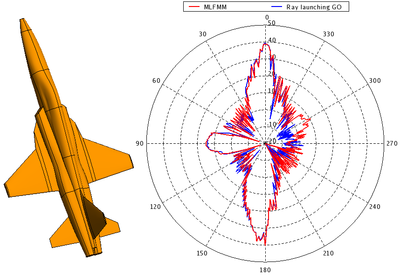Ray Launching Geometrical Optics (RL-GO)
The ray launching geometrical optics (RL-GO) is a ray-based method intended for modelling electrically large dielectric and perfect electrically conducting structures in applications such as lens antennas and radar cross section (RCS) analysis.

Figure 1. RCS of an aircraft at 1 GHz in the elevation plane: Comparison between MLFMM and RL-GO. RL-GO required 33 times less memory.
Feko integrates the RL-GO method with the current-based MoM, by launching rays from each radiating MoM element. The ray interactions with metallic and dielectric structures are then modelled using Huygens sources placed on each ray contact point (for reflected, refracted and transmitted rays) on the material boundaries. The runtime and memory requirements scale almost perfectly for parallel processing, resulting in multi-core CPUs or cluster computers operating highly efficiently while solving RL-GO problems.

Figure 2. Reflector near field calculated with RL-GO.